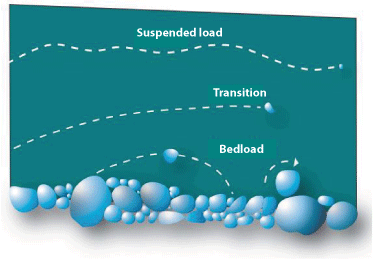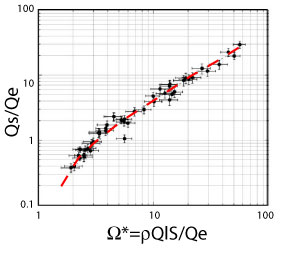

Particles transported by a given flow exhibit different ballistics depending on their size and density. Fine particles are almost transported at flow velocity and rarely touch the bed. Their trajectory is close to the flow path, in suspension in the fluid. One speaks of suspended load. Larger particles travel in saltation on the bed. The larger and the denser is the grain, the shorter is its ballistics and the longer it remains on the bed. These particles constitute the bedload. A common way to evaluate the transport mode is the use of the Rouse number :
Ro= Vs/kU*
where Vs is the fall velocity of the grain, U* is the shear velocity of the flow and k= 0.4 is the universal Von Kármán constant . Large Rouse numbers correspond to large, dense particles that quickly sink in steel water, and are submited to flows that are not fast enough to carry them at flow velocity. Large values of the Rouse number in our experiments, ranging from 6 to 15, indicate that sediment transport is mainly bedload. The bedload transport is the relevant one to study the morphology of river beds. Indeed, large grains constitute most of the bed and then, their motion control the bedform.
TRANSPORT LAW
Bedload transport (Qs) at the outlet of our microscaled braided streams is controled by the water discharge Ql, the slope S, but also by the sediment supply Qe. The transport relationship, found to be linear ( bottom left figure), introduces the effective stream power index as the ratio of the stream power index to Qe. The law remains valid whatever the mass balance (Qs/Qe ranges from 0.4 to 30).
Input and output mass flux correlations in an experimental braided stream. Implications on the dynamics of bed load transport, F.Métivier and P.Meunier. Journal of Hydrology, Volume 271, Issues 1-4, 10 February 2003 , Pages 22-38
© Patrick Meunier